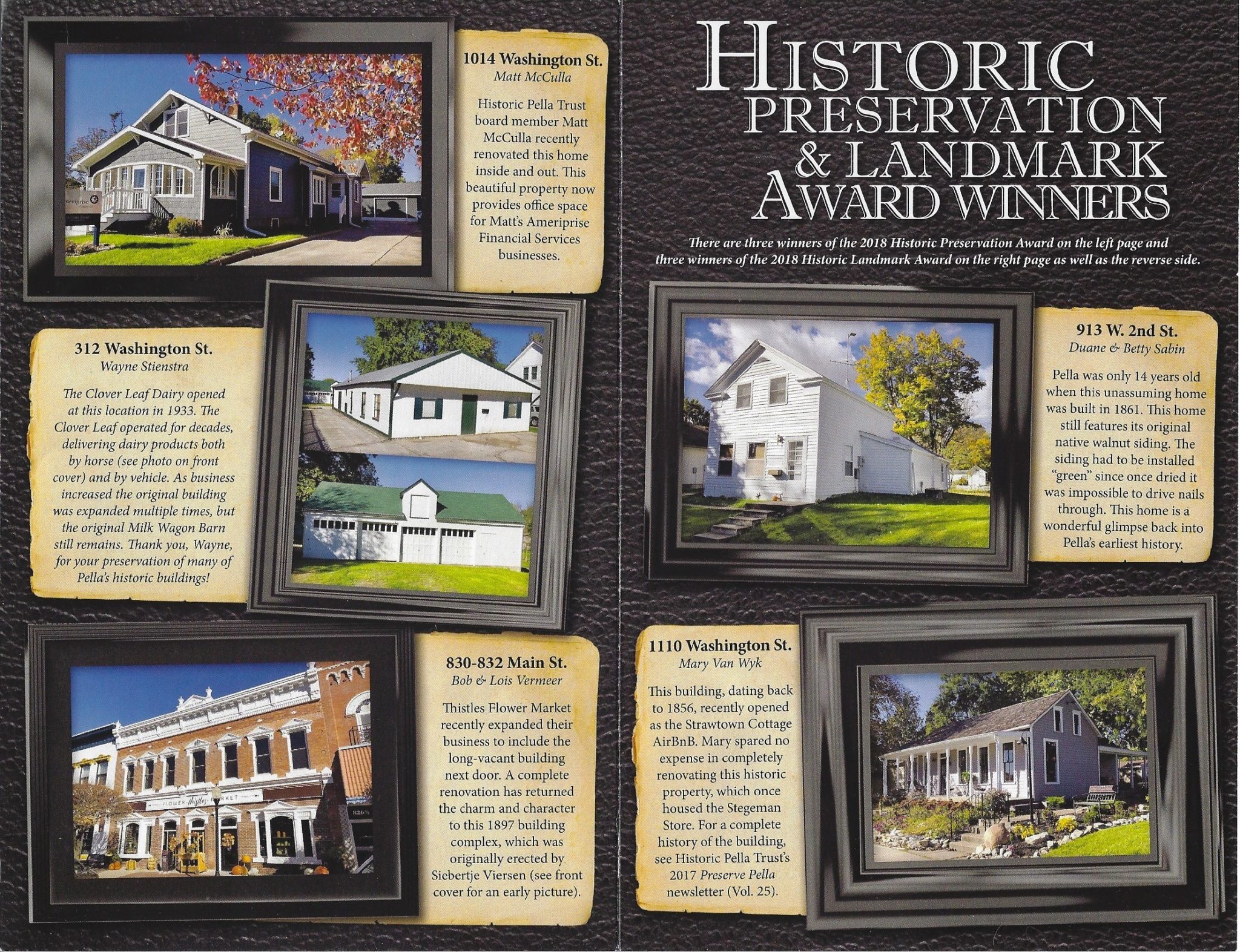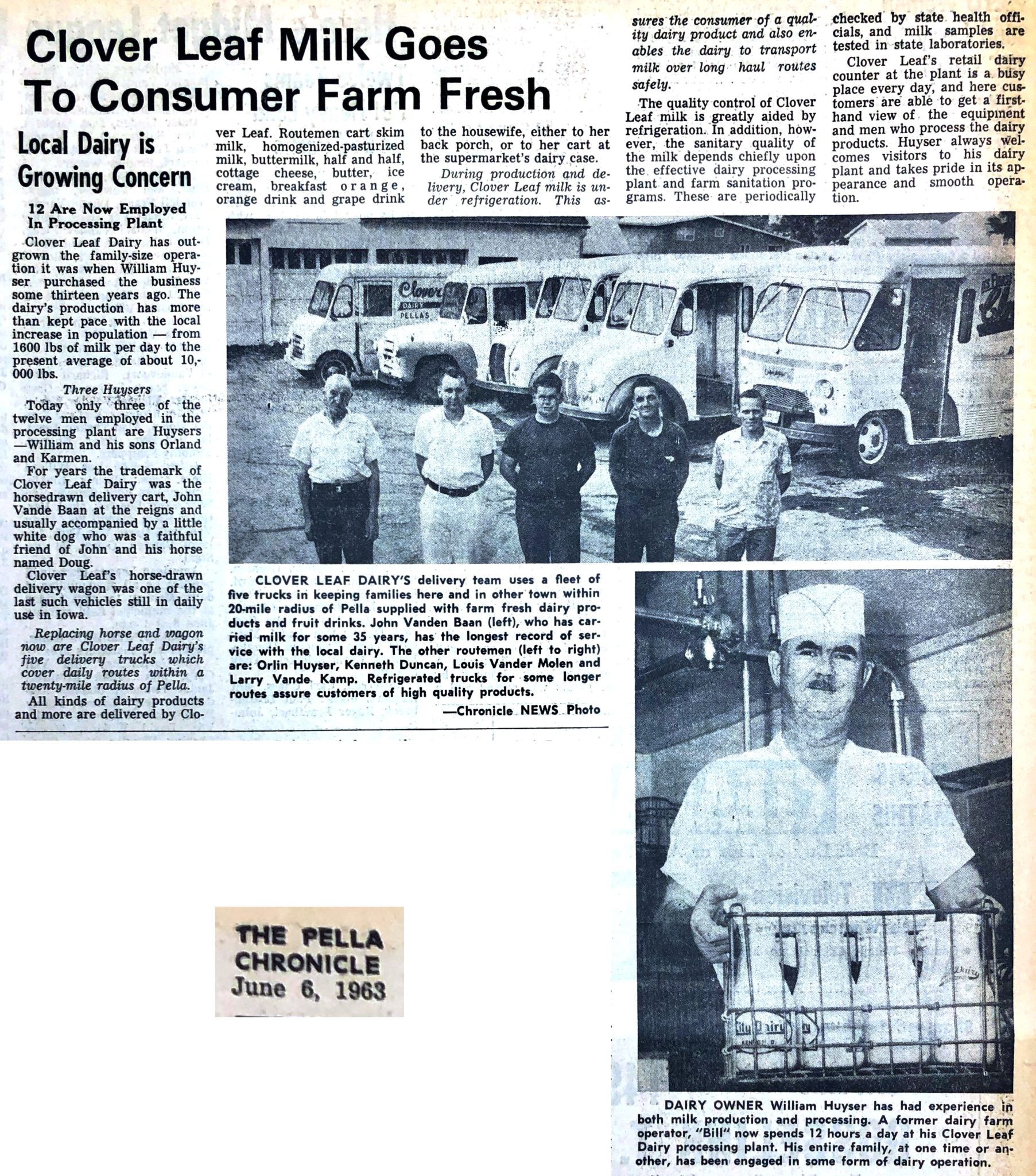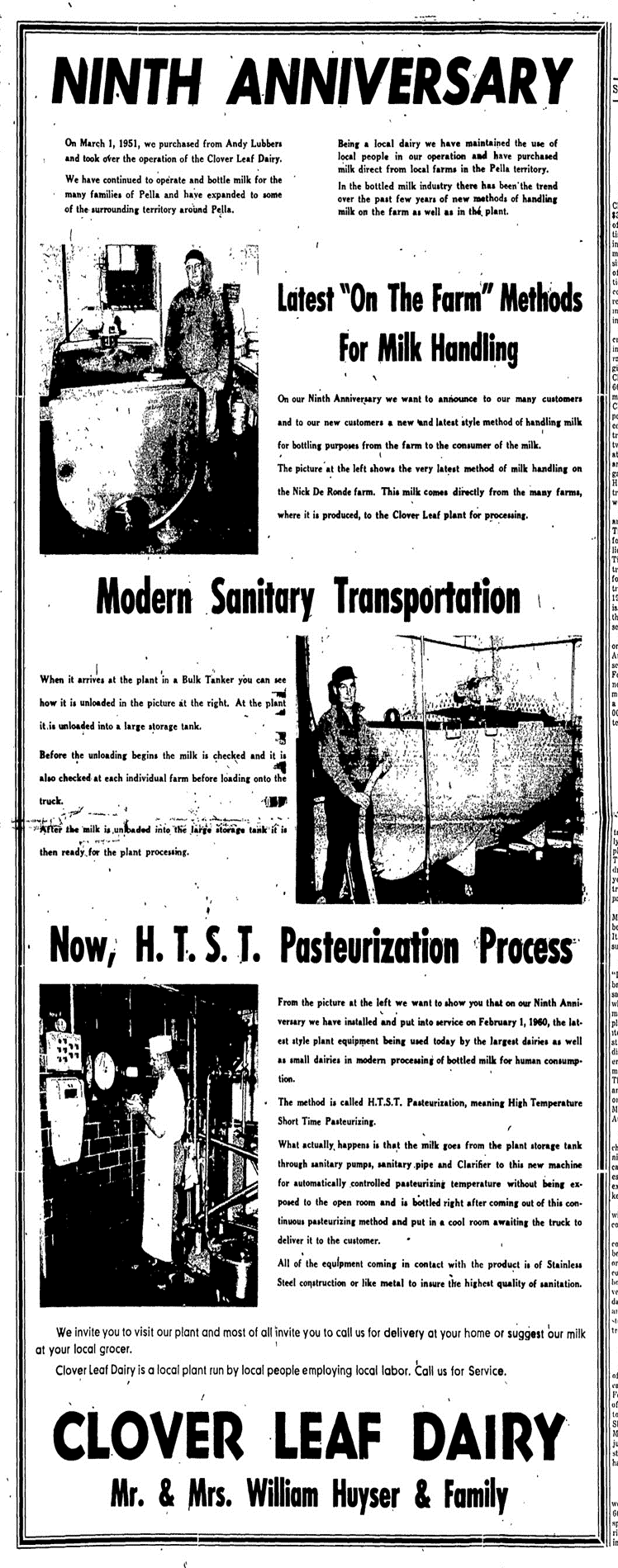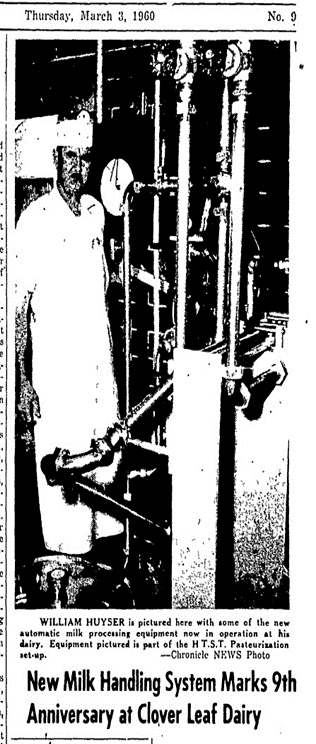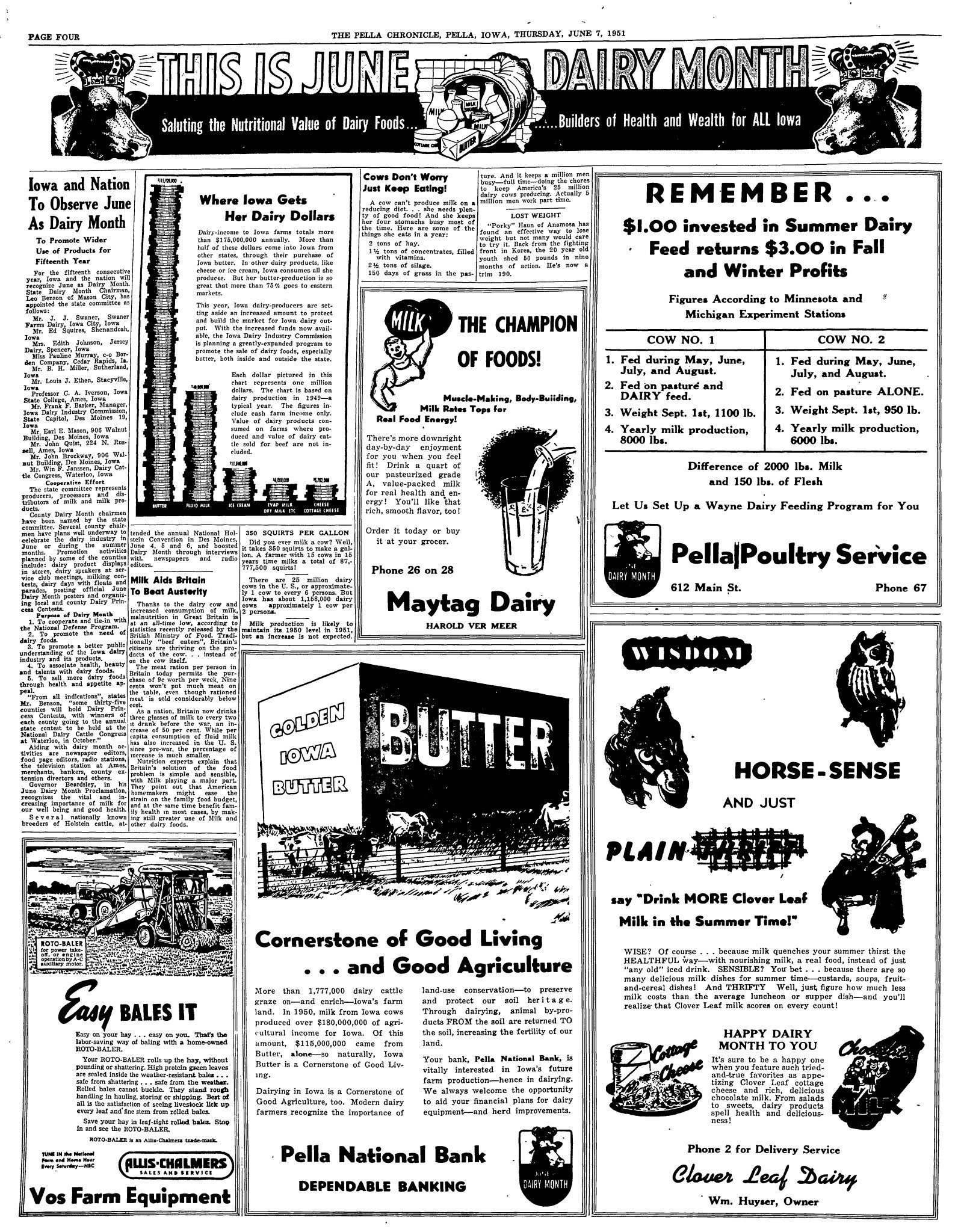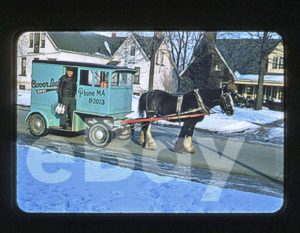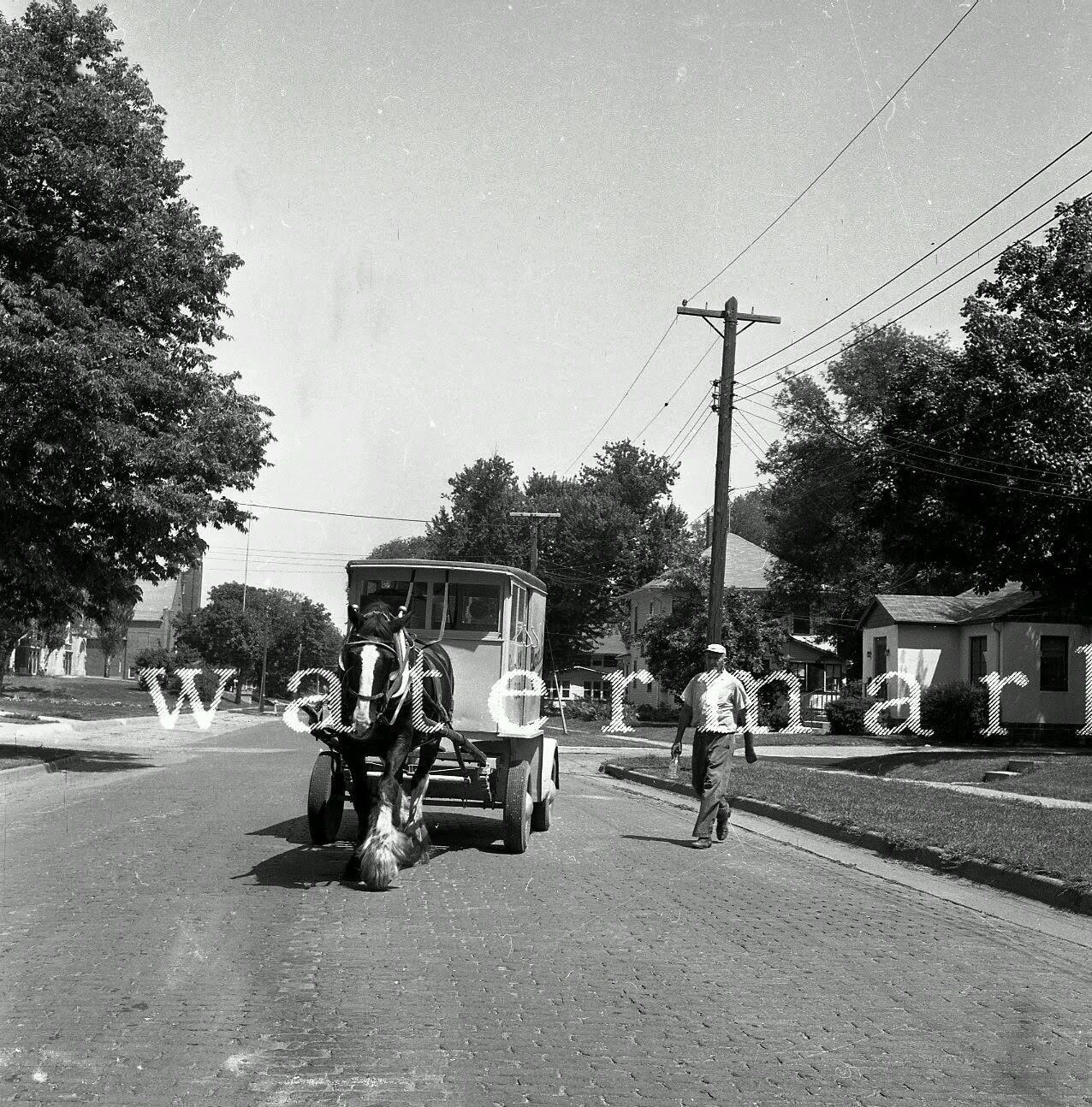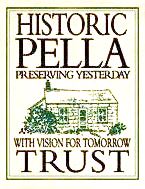
Clover Leaf Dairy and a Love That Lasts a Lifetime…
By Jennifer VanKooten
The Dutch pioneers built straw dwellings among the oak trees in the Northwest corner of Pella after emigrating from the Netherlands. They were part of the Dutch coalition traveling under the leadership of Dominie Scholte. Scholte donated the land for burial plots in 1848 for some of the pioneers. It was incorporated in 1867 as a cemetery and it was referred to as Oakwood Cemetery in 1903. You may wonder what a cemetery has to do with a Dairy. This section of rolling hills was also rich pasture land, the cemetery provided both designated graves and area to expand which needed to be maintained. Livestock was a vital part of pioneer life both in working the land, producing food and controlling the growth. Agriculture helped make Pella sustainable and pasture was an added value product for the cemetery trustees.
In May or June of 1906, Hendrik and Johanna Lubbers immigrated to Pella from the Netherlands. Arriving with the Dutch couple were their three small children ages five, three, and six weeks old. Hendrik Lubbers was employed as the caretaker of Oakwood Cemetery. By 1907, Hendrik had invested in a few milk cows and began selling the extra milk by making the deliveries with a horse and two-wheel cart. This started a dairy business for the Lubbers’ family that spanned three generations! The Lubbers family eventually had six children, Katheryn, Martin, Grace, Klassina, Andrew and Gerard. They also brought Tony and Gerrit VanSetten into their family after their parents passed away.
Needing more space for the dairy business Hendrik purchased a home at 314 Washington Street. This 1892 Victorian style house was known for its ornate features along with a beautiful flower and vegetable garden. There was land to the east of the house to construct a building that still stands today! Hendrik established his milk processing business and named it The Clover Leaf Dairy. Behind the dairy he built a stable with a stall for the delivery horse and a place to store the milk delivery wagon. Later it was converted into garages to shelter the delivery trucks. The Lubbers’ Dairy employed many high school aged boys to help with the processing and bottling of the milk. My neighbor, Don Verros was one of these boys. He lived a few houses down on Washington Street and remembers going after school to wash the milk and cream cans. He reflected that it was heavy and hard work.
It was in 1933, during the depression that the farmers tried to withhold milk supply in Wisconsin to raise the prices. Their strikes turned violent and National Guard was called to control the protests. This caused some farmers to lose their lives standing up for a fair milk pricing. Pella’s milk supply was not affected by the national and Wisconsin conflicts because there was a local dairy business.
Milk was promoted as the wonder food by the Roosevelt government; full of nutrition for struggling families, who on average needed to spend one fourth of their income on food. The depression was especially hard for farmers, struggling to make ends meet because of low prices on their products. Electricity was still new to farms and many could not afford it. Milk was perishable and needed to be picked up soon after the cows had been milked.
It was in 1933 that Andrew Lubbers purchased the Clover Leaf Dairy from his dad. His family continued to buy milk from local farmers for bottling and delivery. Every day raw milk was picked up at several dairy farms.
Times were hard and farms small, most with less than 10 cows, so it took many farms to supply enough milk for Pella.
The milk was brought back to Clover Leaf for processing in to cream, milk and cheese. The community was fortunate to have access to dairy products.
The predictable rhythm of the delivery horse and wagon bringing the fresh milk to each porch was a thankful sight to many in a time of shortage and economic stress.

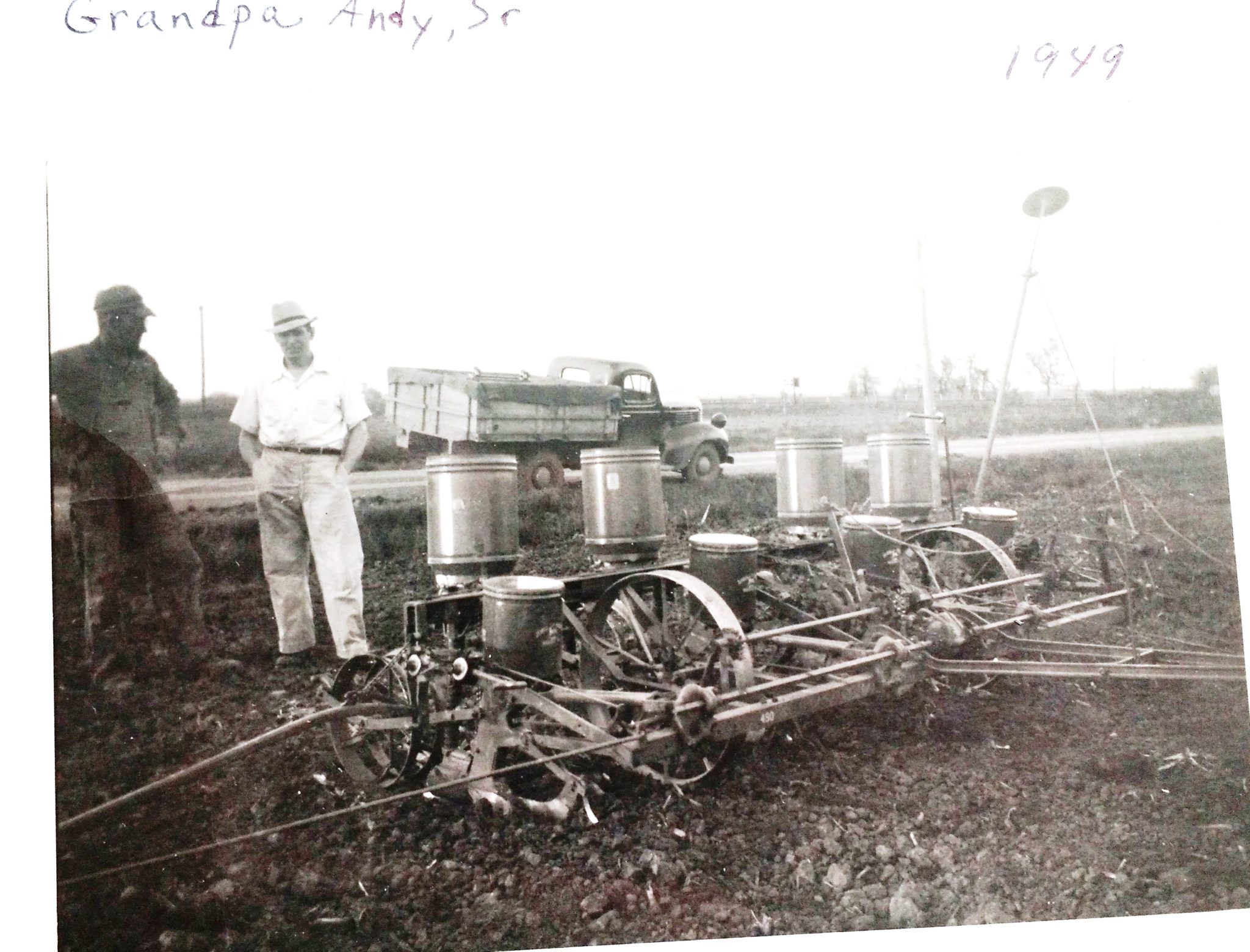
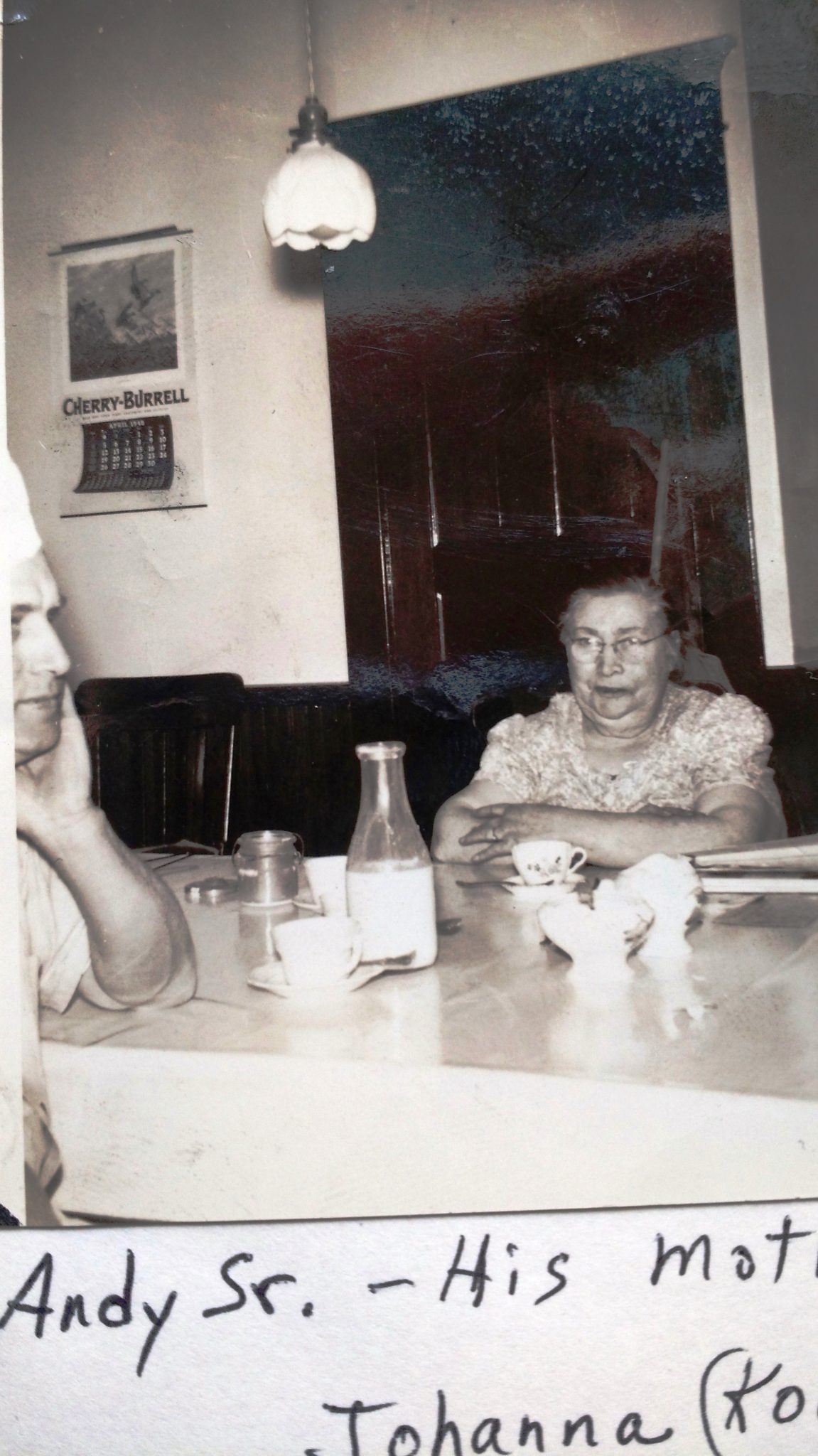
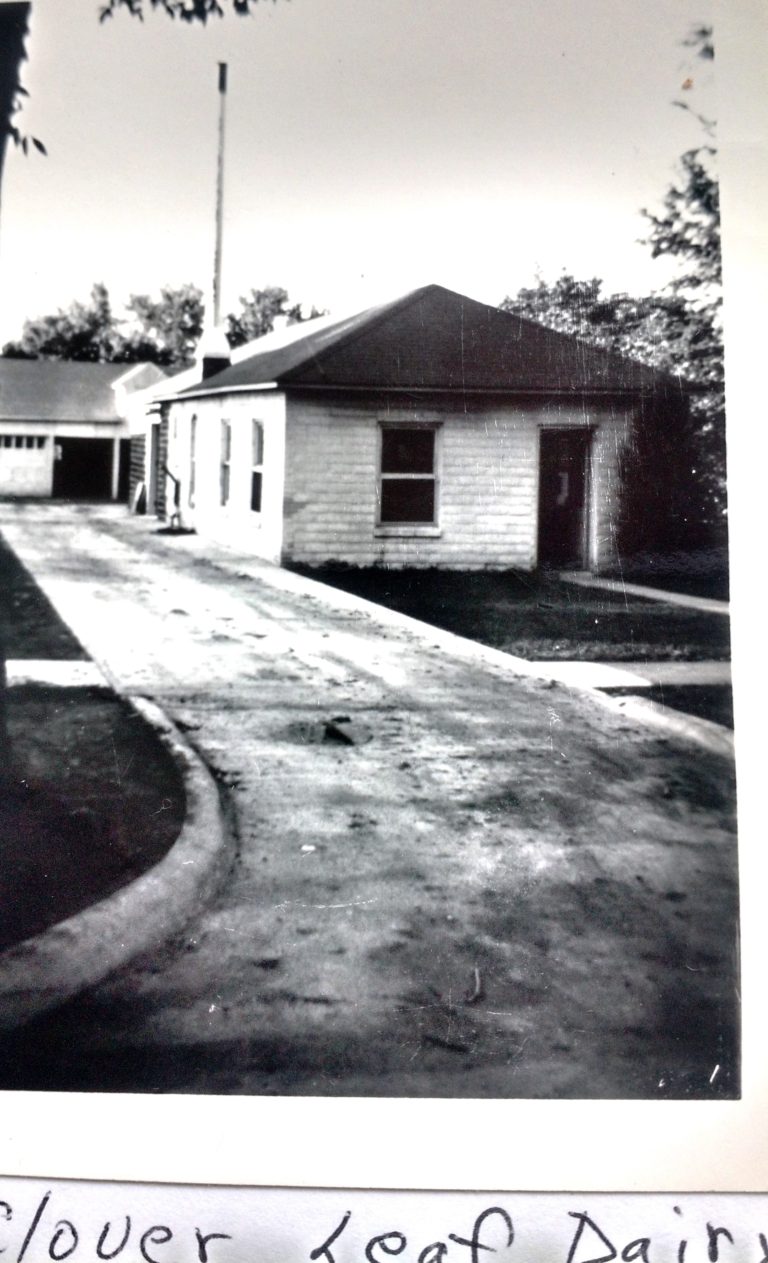
John Vanden Ban, an immigrant from the Netherlands, moved in with Andrew Lubbers’ family and began working for the dairy in 1943. He became the delivery man with the milk wagon and the large Clydesdale named Douglas. He also had a little dog named Pooch that was always with the delivery wagon.
It was a time when jobs, truck parts and gasoline were scarce, so delivery by horse drawn wagon was practical. Regardless of the weather the people could expect to have a fresh bottle of milk in their metal porch box each day. In the winter John had a small gas heater to keep the milk from freezing in the wagon. In the summer he would only do a half route before restocking at the dairy, to keep the milk from getting too warm.
If the weather was bitter cold and the homeowner didn’t retrieve the delivery in time the cream might freeze and pop the top off. I was told this made my Grandma Kate very angry but the kids loved this ice-cream treat with a little syrup or sugar sprinkled on top.
Most people listened for the delivery and promptly brought their milk inside. The empty bottles were also placed into the porch box for John to take back to be sterilized and reused.
I
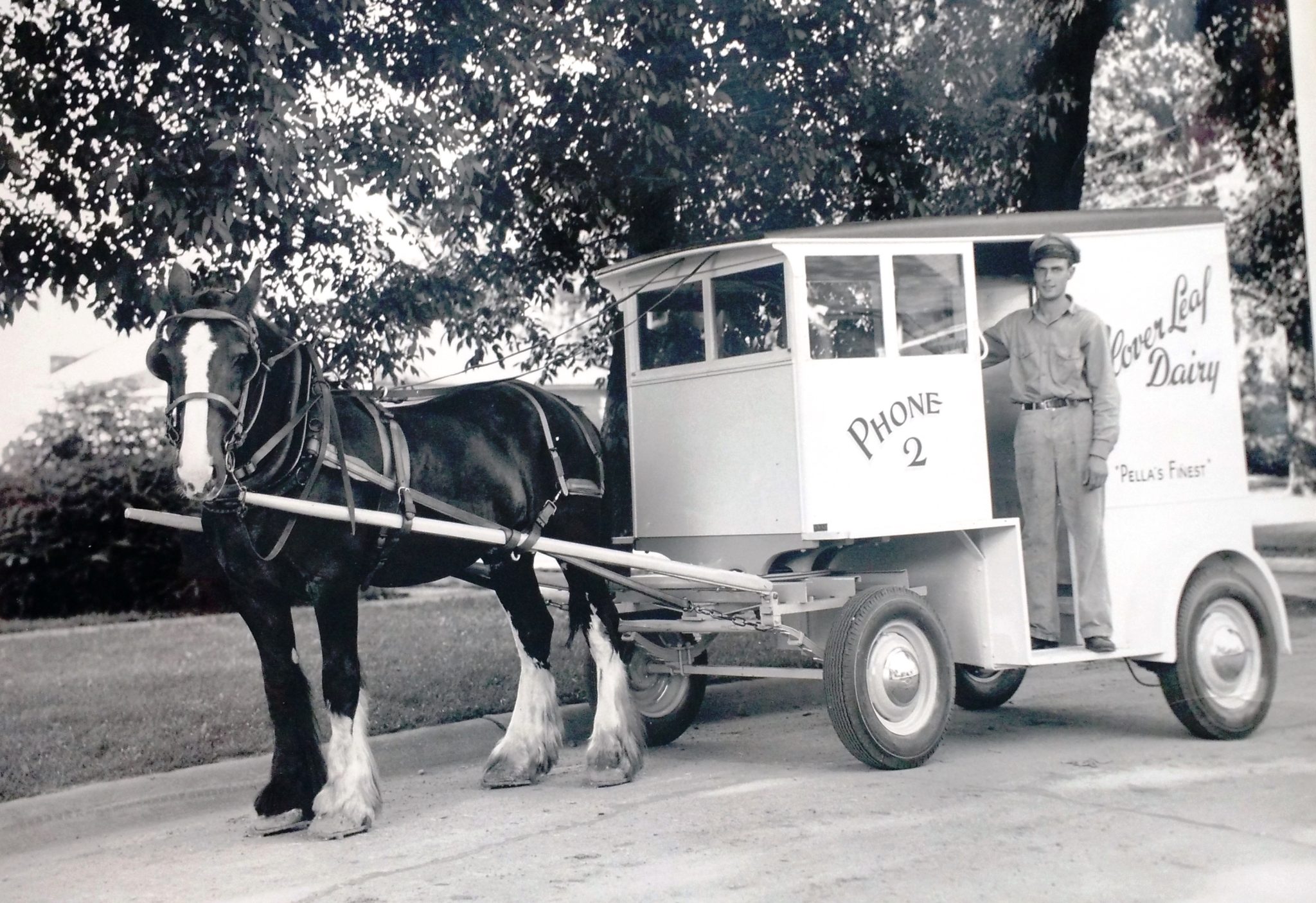
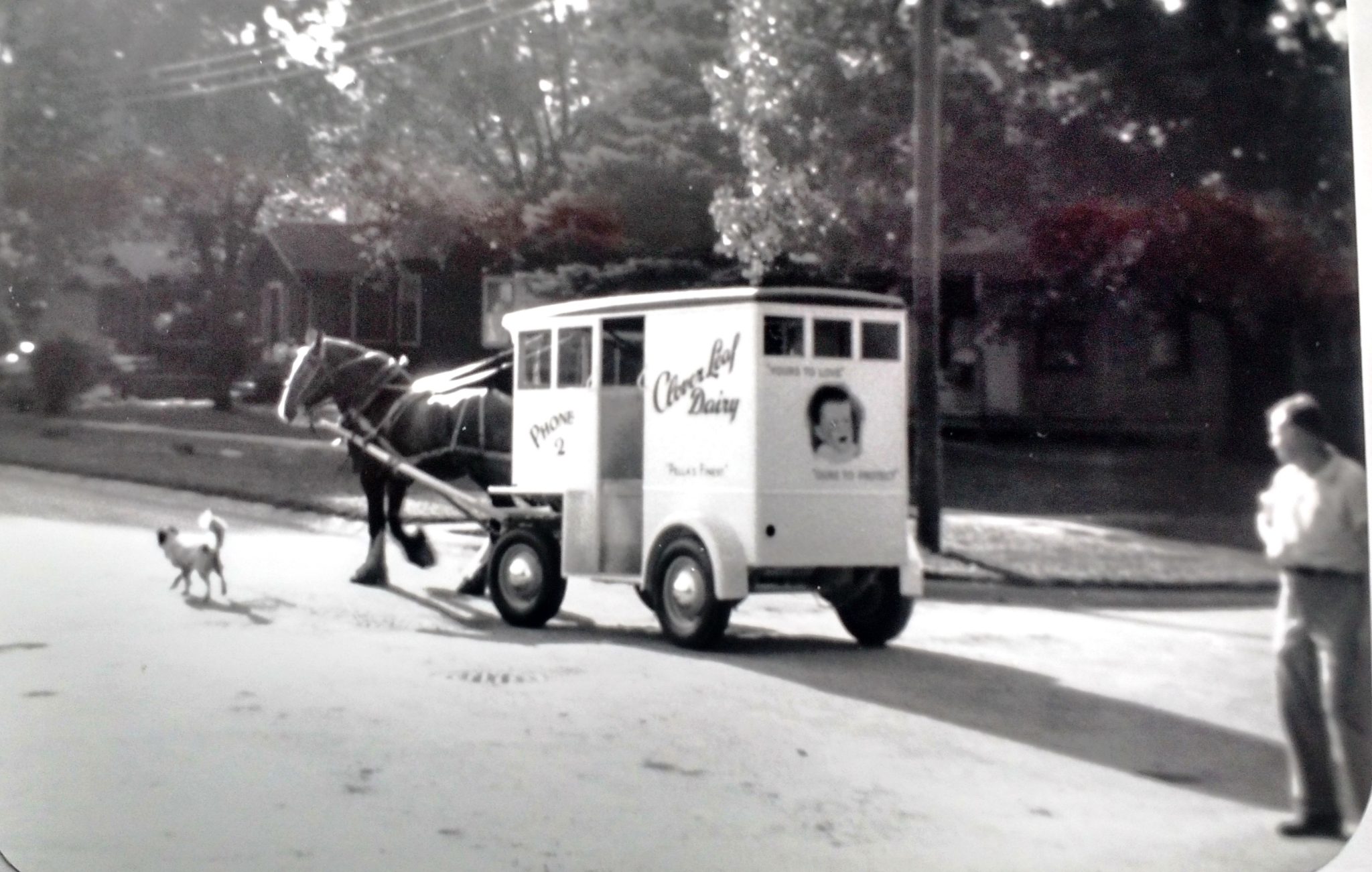
It was Tulip Time of 1947, Andrew Lubbers and John Vanden Ban tried to put the milk wagon and Douglas in the Tulip Time parade.
This attempt at featuring Pella’s famous milk horse was not very successful. Some remember the horse and wagon in the parade so not sure how many times they tried.
Douglas was so comfortable with his daily routine that he was upset at being told to turn the wrong direction at the corner of the parade route, causing an end to his parade horse career.

In March of 1951 Andrew Lubbers sold Clover Leaf Dairy to William “Bill” Huyser. The Huyser family farmed and milked south of Sully, and were looking forward to moving to the Pella location. William and Stella Huyser had seven children, four boys and three girls. They were Forest, Irvin, Orland, Beverly (VanZee), LaVonne (VandeKamp) LaVoe (VanDyk) and Karmen Lee.
Bill and his wife Stella ran the dairy business along with the three daughters and two of their sons. The oldest son, Forest was already married and farming with his father-in-law by Oskaloosa. Karmen was seven years younger than LaVoe, so he was not quite as involved with the business part. As the daughters married they didn’t work in the dairy as often and Orland was called into the military. Irvin did milk pick up from the local farms for about a year. The US Government had established more regulation over the milking industry and regulated milk prices by this time. The local dairy farms could not keep up with the milk demand; so the raw milk for dairy processing came from the Sully Dairy Co-op.
.
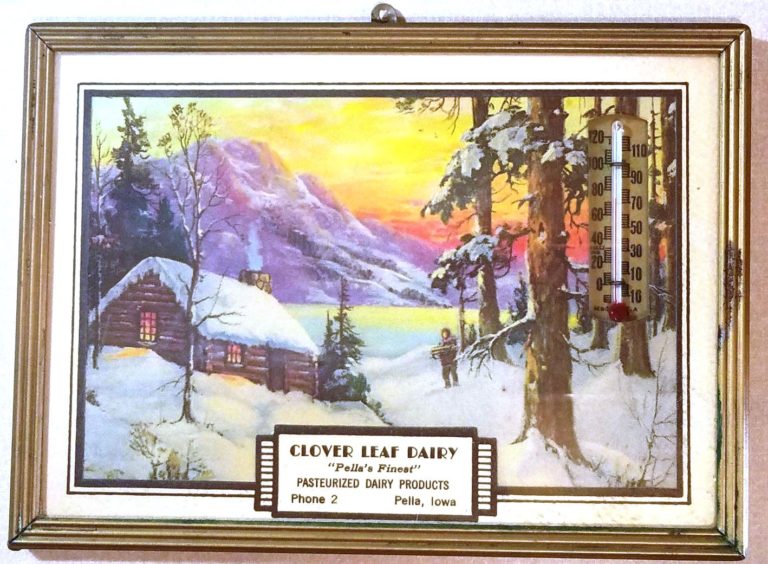
The Huyser’s were not new to the dairy business. They took over the family dairy farm by Sully. It was first owned my Stella’s dad and later by her brother Paul VandeKamp. They would bottle milk into quart jars and market it to several customers. Her grandfather retired to Sully and continued to deliver bottled milk in a coaster wagon. He did this until he passed away at the age of 70, suffering a stroke while delivering on his milk route.
It was in the mid 1940’s that Bill and Stella milked around 40 cows on this Sully farm. It was LaVonne and her sister, LaVoe, who would bring the cows back and forth from the pasture by horseback. In order to have enough pasture they rented more land about a mile ride down the highway. Twice a day the girls would round up the herd, travel down the road to the milking parlor at their home for the cows to be milked. Then they brought the cows back up the road after they were done milking. At this time, they had a building on the farm to process, bottle and market their milk products from. They would process their milk and deliver it to families in the Sully and Lynnville area. Irvin would pick up separated cream from local farms and sell it to the Sully Co-op for butter production. One afternoon on a milk route by Searsboro, Irvin didn’t notice the train and it smashed into his truck leaving it a pile of twisted metal. Thankfully he was not hurt badly in this accident.
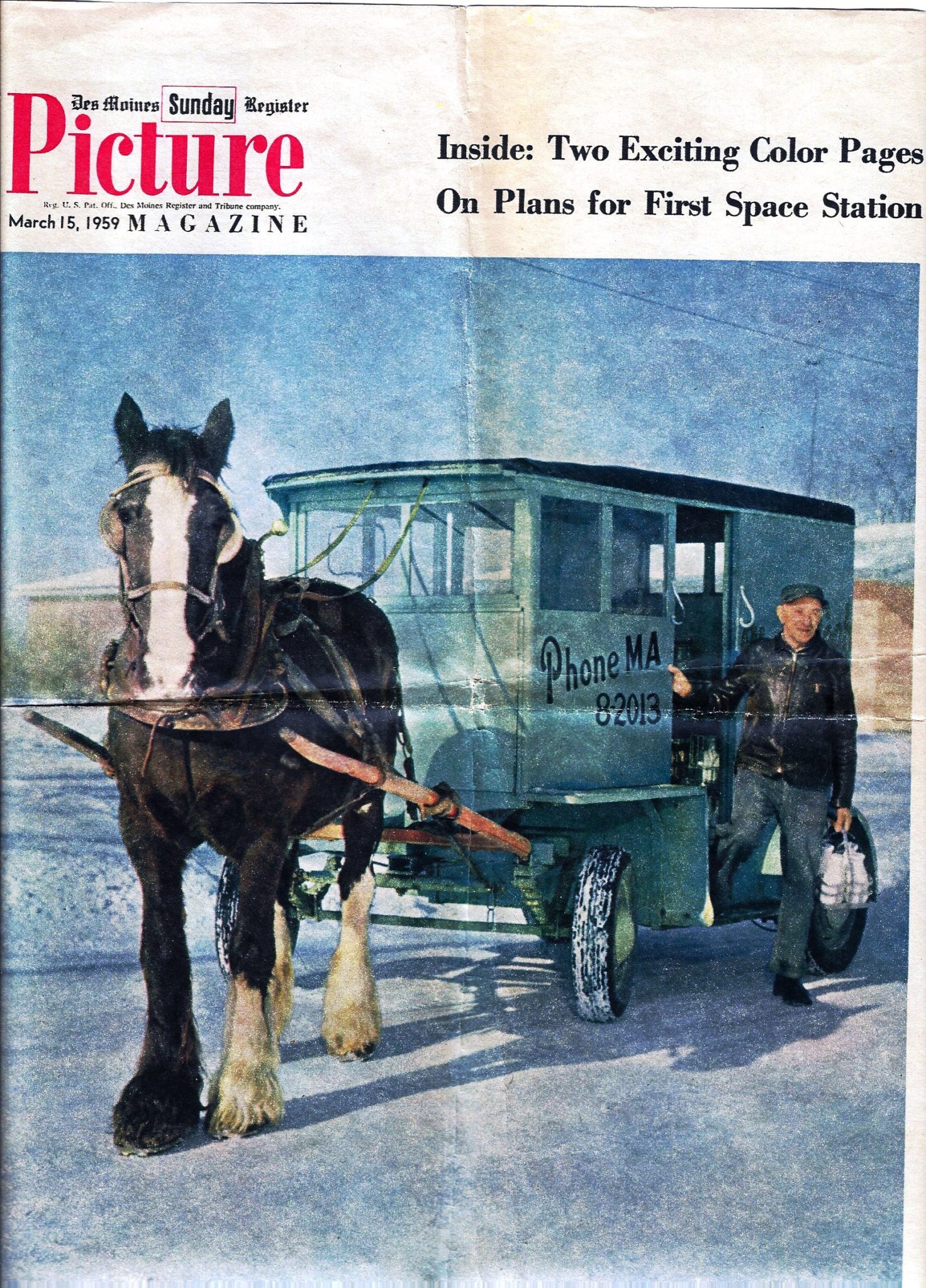
John Vanden Ban continued to work for William Huyser, delivering milk with Douglas the horse until 1961. John had an apartment in the Pella Hotel uptown.
Pella residents looked forward to the sound of Douglas coming down the street. They were disappointed when John had rubber shoes put on Douglas once, so he went back to the traditional steel shoes. Douglas would get new shoes once a month from a Des Moines farrier. It was estimated that Douglas weighed 1,350 pounds.
The first milk wagon had steel-banded wooden wheels that squeaked along the city streets and seemed to last forever. The newer delivery wagon had rubber car tires, prone to an occasional flat.
John’s day would start at 8 am and he would be done about 3 pm, covering a route of 12 miles a day. John would take out a crate of milk bottles and carry them from house to house and Douglas and Pooch would follow along on the street and stop at the next corner.
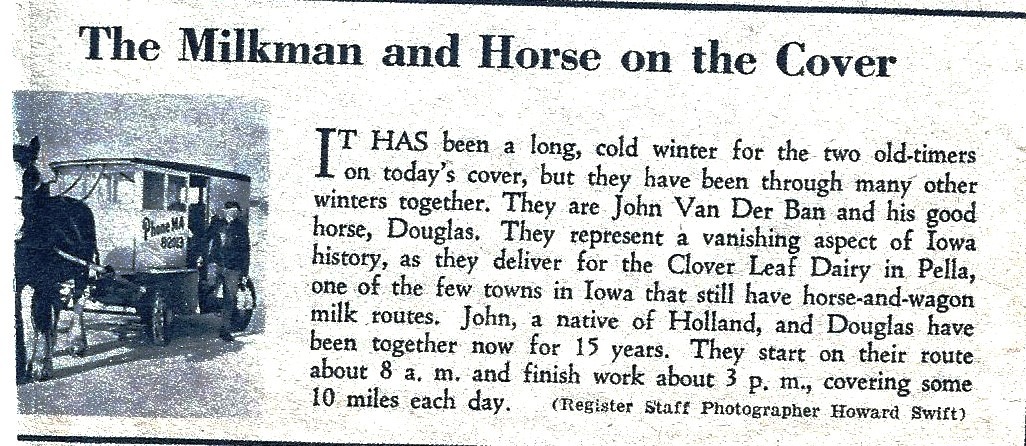
The Huyser’s started a long time Tulip Time parade tradition. Their employees carried a two-man cheese basket handing out samples of Komijnekaas, which is a gouda-style cheese seasoned with cumin and caraway seed. This parade entry is still enjoyed during Tulip Time today. There is a picture of Bill Huyser in front below!
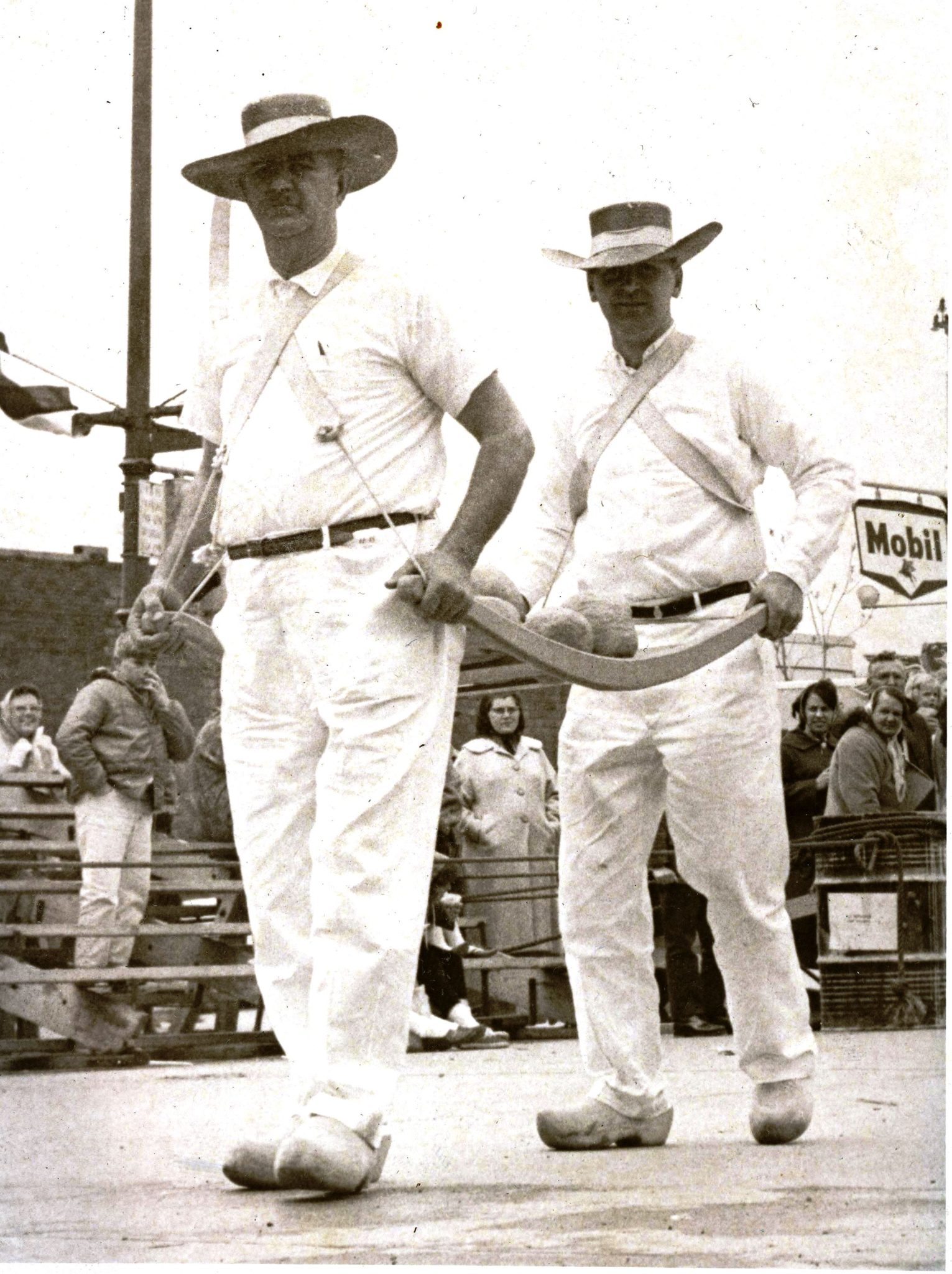
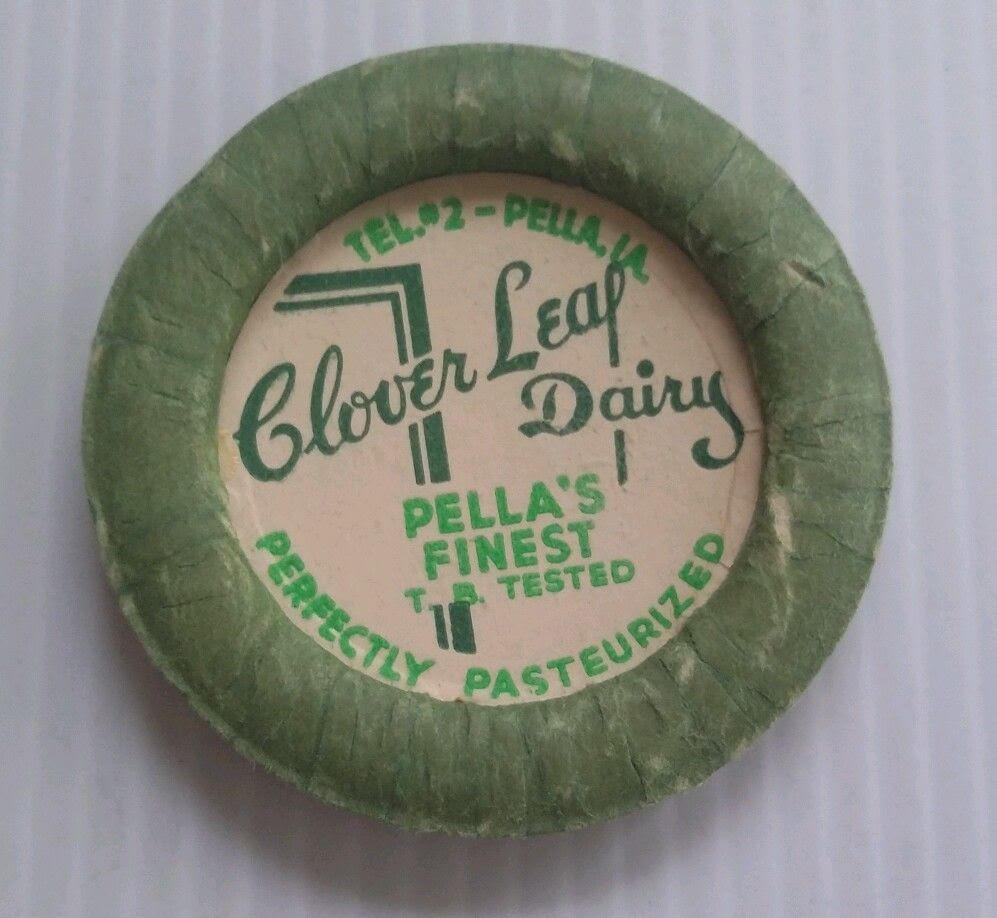
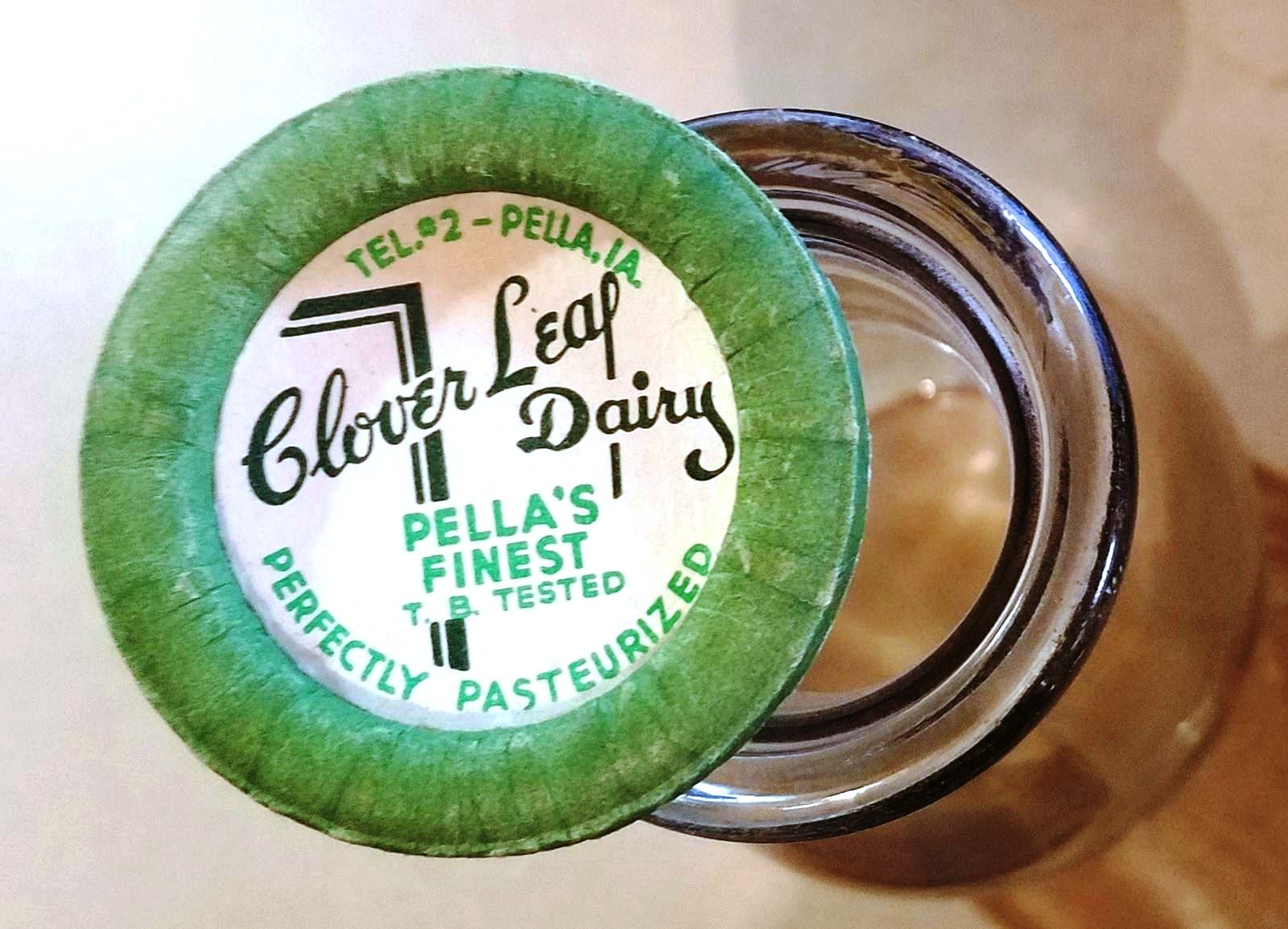

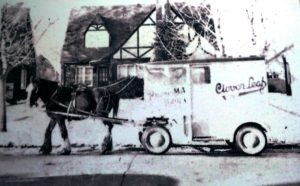
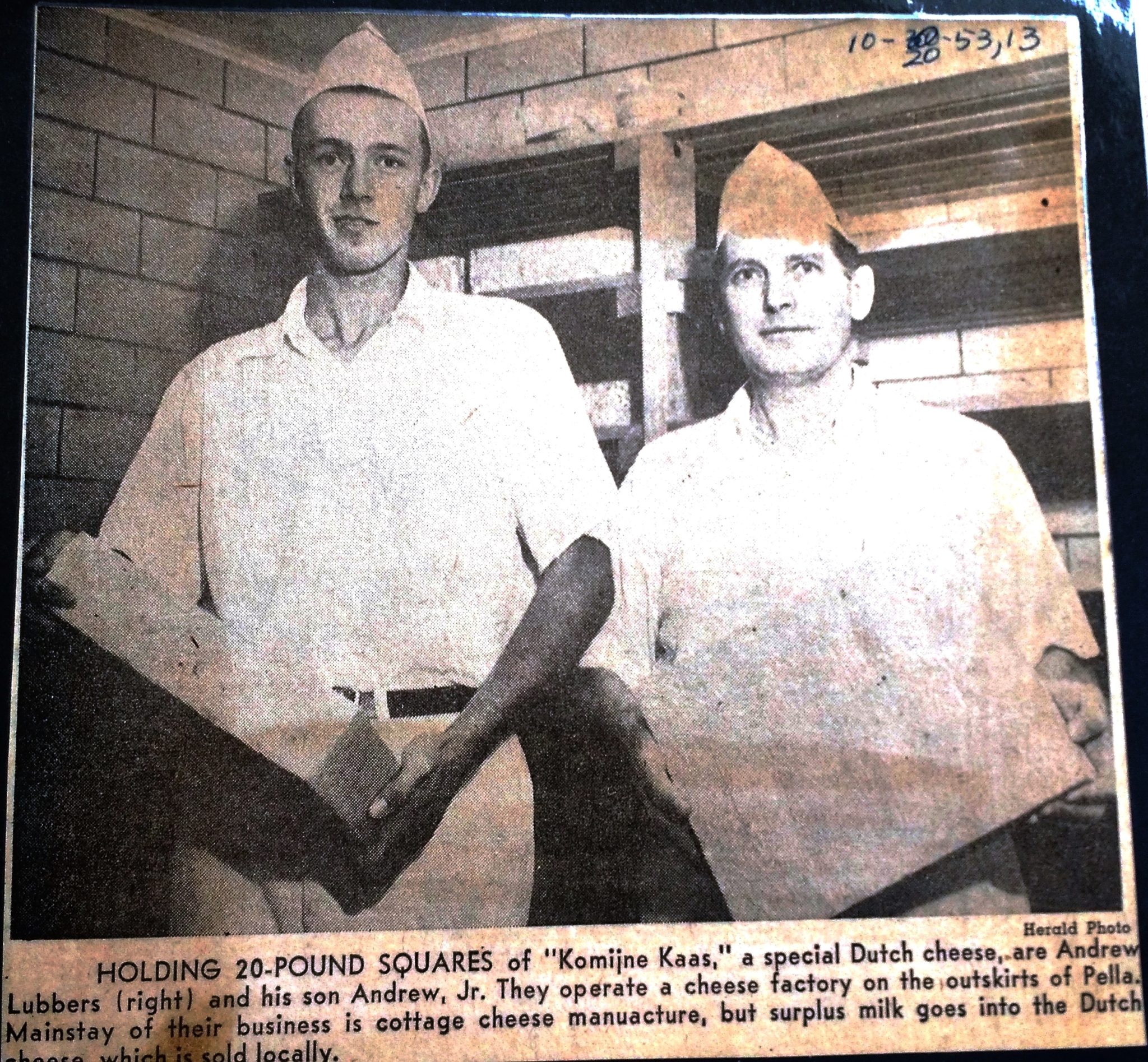
I am going to take a moment now to mention that in 1953, the Clover Leaf Dairy gained some competition, Andy Lubbers; the previous owner decided he wanted back into the milk business. Andrew Lubbers and his son, Andrew Jr. purchased some ground on east Oskaloosa Street and built a brick building on the southeast corner of Pella.
This new Lubber’s Dairy offered over-the-counter sales and bulk delivery. Many people will remember the window where you could watch the cottage cheese being made. The fresh milk products, butter and cheese were delicious and missed by many in 1993.
Our Facebook followers often mention the Lubbers’ ice-cream mix. Pella Dairy Queen even used that mix when making their soft served ice-cream.
The Lubbers’ Dairy closed on Dec. 1993, due to the retirement of Andrew Jr. and Joyce Lubbers. The legacy of our hometown dairies came to an end.
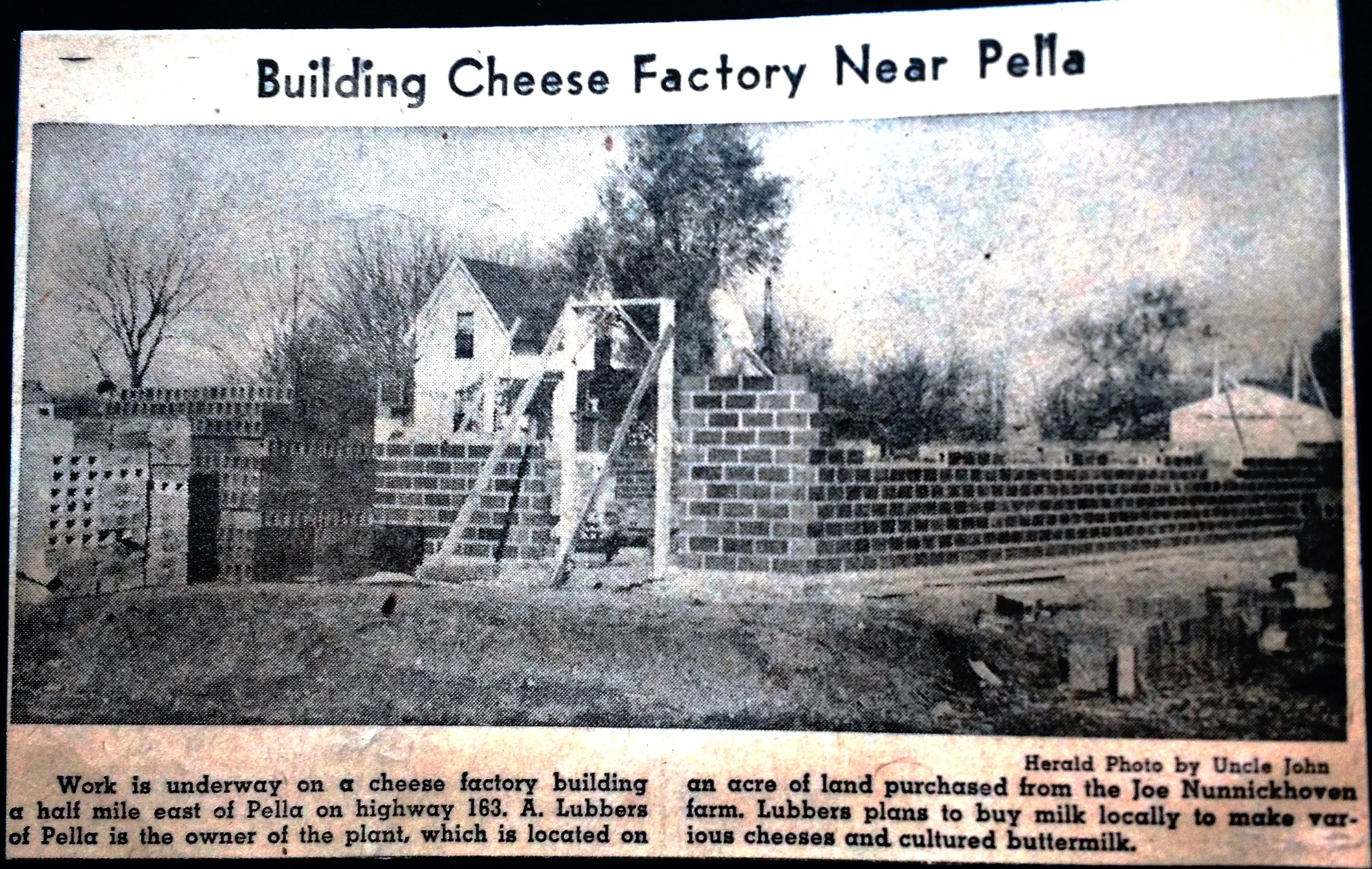
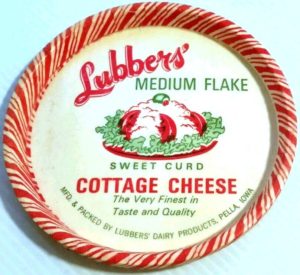
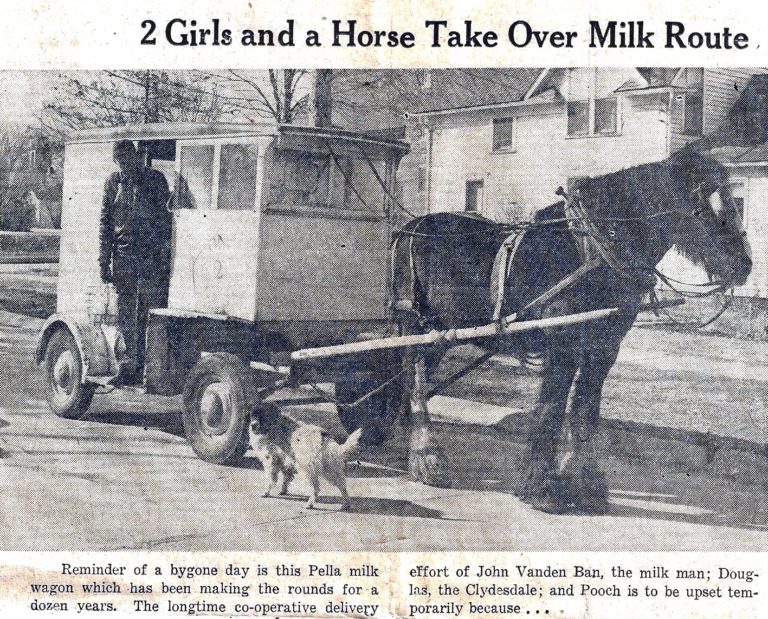
Back to our Clover Leaf Dairy story, in 1959, Milkman John Vanden Ban was hospitalized and had surgery.
LaVonne and LaVoe, Huyser sisters ages 17 and 16, took over the duties with Douglas and Pooch of delivering the milk. The Clydesdale, who had been doing this route for 17 years, taught the girls just where to stop! Douglas knew the route by heart; he probably could have delivered the milk alone if residents would have gone to the wagon to get the milk themselves.
The little dog named Pooch looked like a likeable pup but he did not appreciate anyone coming close to the wagon and horse. He would bark and become protective and went along everywhere with the wagon. So he did his job but the dog lacked in some social skills. The once young show horse, Douglas the Clydesdale had delivered milk for 17 years. In 1959 he was put out to pasture to enjoy his days in the sunshine and green grass. Pooch his companion became blind before crossing Rainbow Bridge.
[The photo to the right is of LaVonne and LaVoe Huyser doing the milk route for John VanderBan. They are daughters of Bill Huyser, owner of Cloverleaf Dairy]
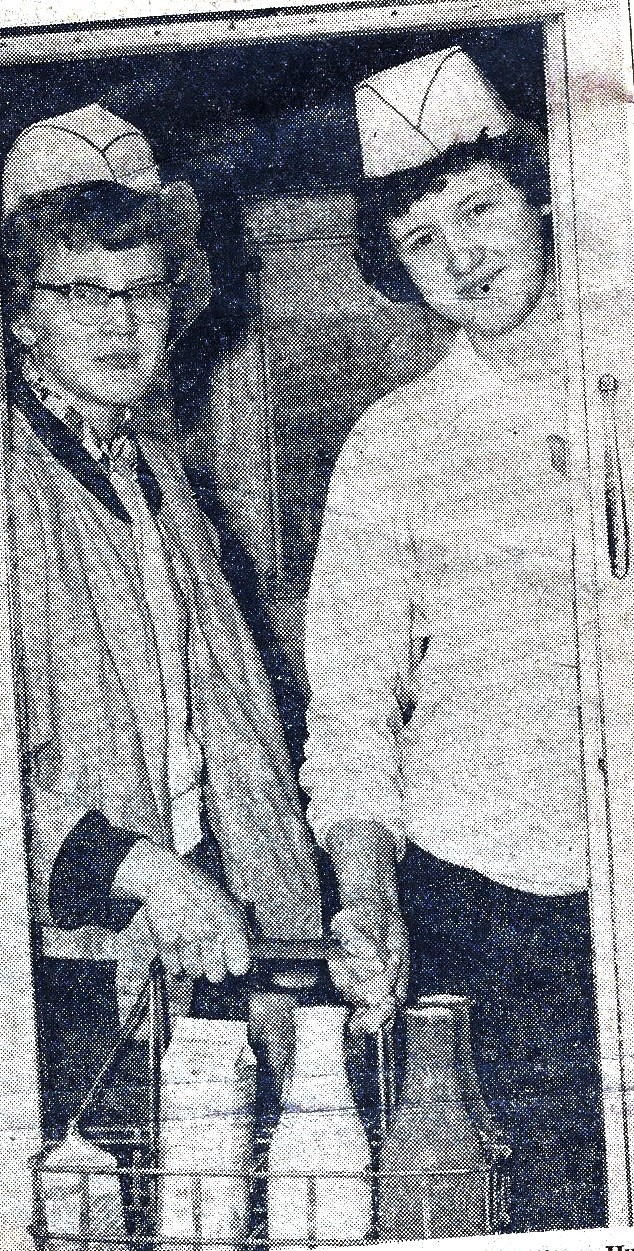
Larry VandeKamp was just home from the Navy when he applied for a job at the Clover Leaf Dairy in Pella.
Larry recalls that during his interview with Bill Huyser, in the Washington Street home, that Bill and Stella’s daughter was in traction in a hospital bed in the living room with a back problem. Her name was LaVonne Huyser. It took around three weeks for LaVonne to recover and return to the dairy work.
Beverly, Lavonne and her younger sister LaVoe worked to prepare and bottle the milk at the dairy. Beverly was the person who took care of the culture in making the cottage cheese; she was the best in the family at knowing when it was just right.
Larry helped with the milk process, bottling and deliveries and worked for the dairy until it closed in 1967.
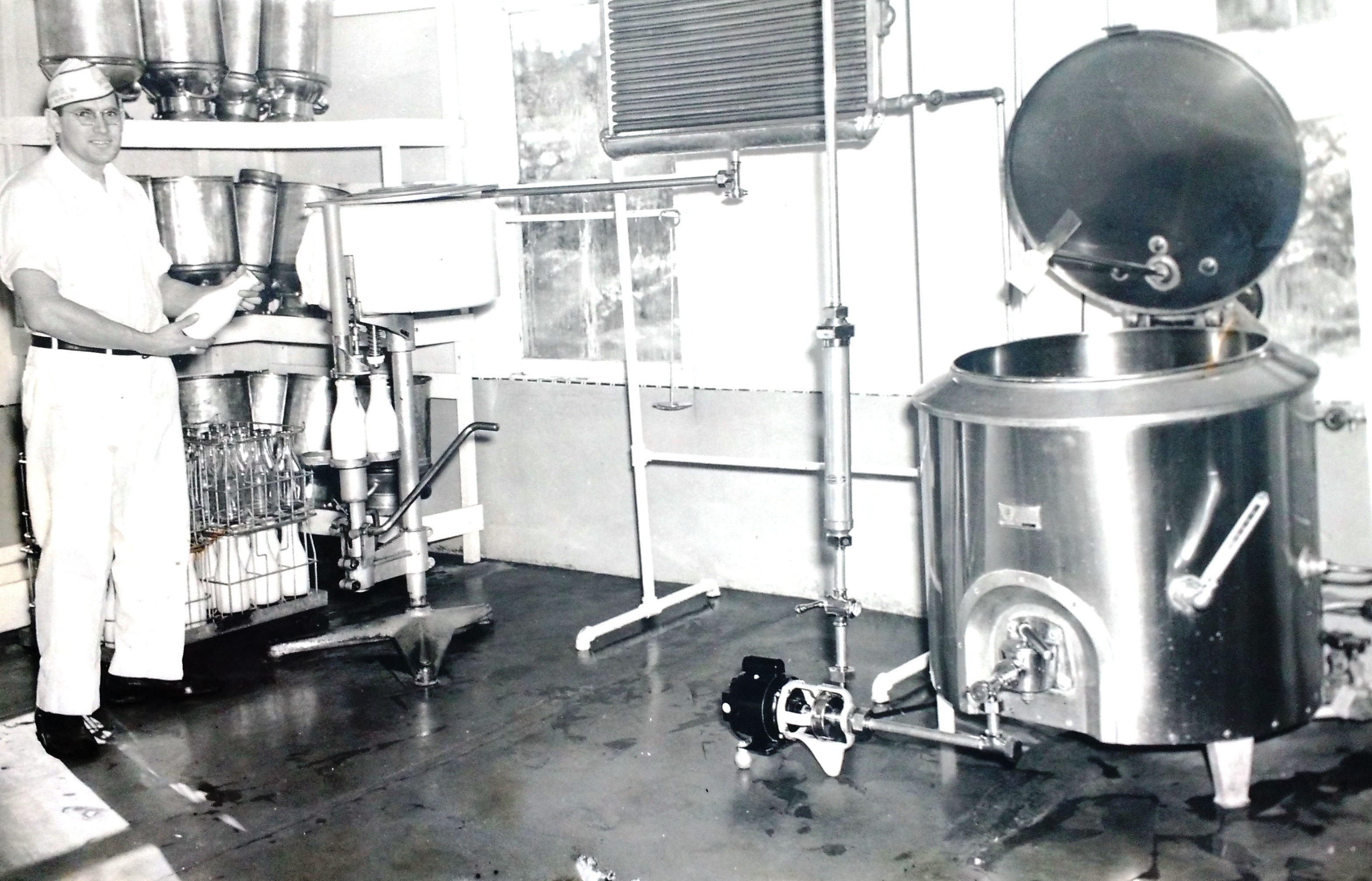
Clover Leaf Dairy had windows that let you see into the processing area. They made many products from the milk including cottage cheese, ice cream mix in vanilla and Dutch chocolate, cream, buttermilk etc. They had a large wooden butter churn but only a select few customers were lucky enough to buy their limited supply of butter on a regular basis.
Cloverleaf would package individual size cups of ice-cream that were sold to the schools for the lunch program.
In February of 1960, the dairy upgraded to stainless steel pasteurization equipment to meet new milk production regulations. This equipment could perform a high temperature short time pasteurizing process. This process also kept the milk from contacting air between the storage tanks to the new style of milk cartons.
The Huyser’s had an ice-cream shop on the North East corner of downtown beside the Wormhoudt’s furniture store, between the brick building and the sidewalk in the 1960’s. It had sliding windows to serve the ice cream from and was open every weekday during the summer months and on Friday nights when the stores stayed open later. They served cones and dishes with a variety of toppings to choose from. It was a very busy location and overwhelming during the Tulip festival. One friend said she remembered that an ice-cream cone cost five cents.
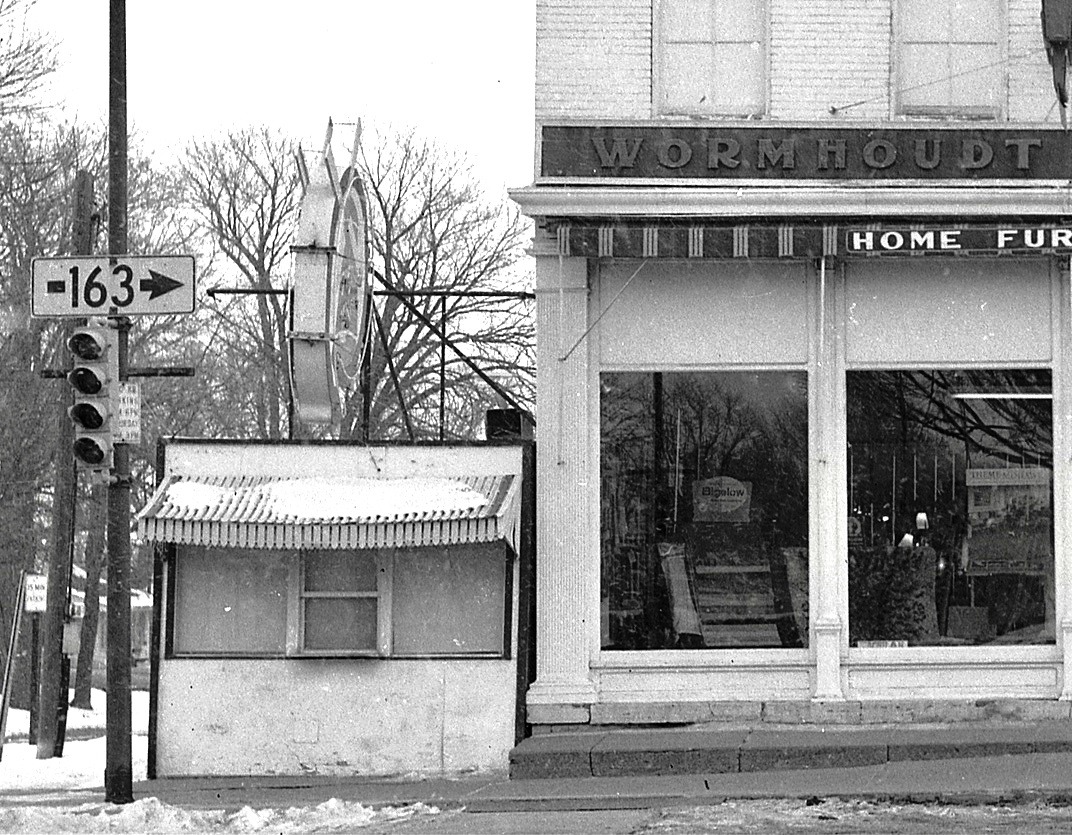
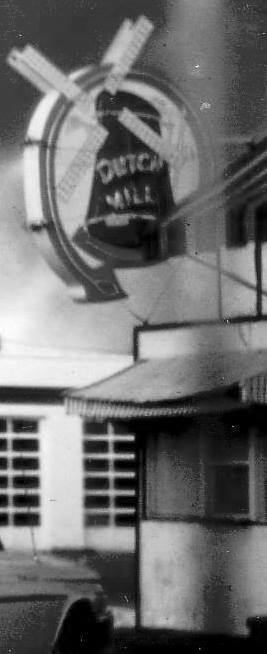
Lavonne Huyser and Larry Vander Kamp were married on Nov. 11, 1960.
Larry continued to work for LaVonne’s dad until the dairy closed.
This love story continues today with
3 children, 11 grandchildren and 15 great grandchildren.
Personally, I remember getting our milk from local dairies and not from a grocery store until the 1990’s. In the early 1960’s our family lived on East Third and Franklin Street. We didn’t get home delivery but mom would send my brother two blocks down the street to pick up milk products. Our Grandpa Gerrit made a wooden box with a handle to carry the cartons/ and or bottles in. It was an easy downhill walk to the dairy but an uphill climb with the heavy milk! He would ride his red Schwinn bicycle with the baskets on the back. I remember going a few times even if I was just a tiny kid! We moved towards Knoxville in 1966. Then our family started to get our milk from a dairy on the old Pella-Knoxville road. It came in 1 or 2 gallon refill bags with a spout that was placed into a special wax covered cardboard box that stayed in your fridge. When Dad started working in Pella, we always bought milk products from Lubbers. My husband and I stayed their customers until Lubbers’ Dairy closed.

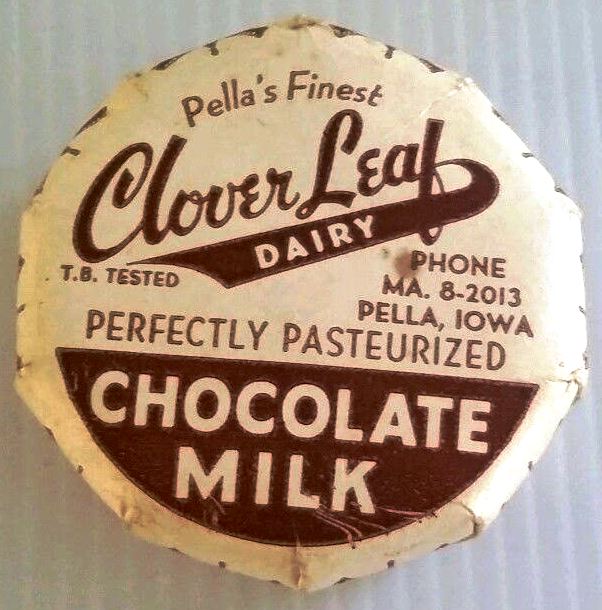
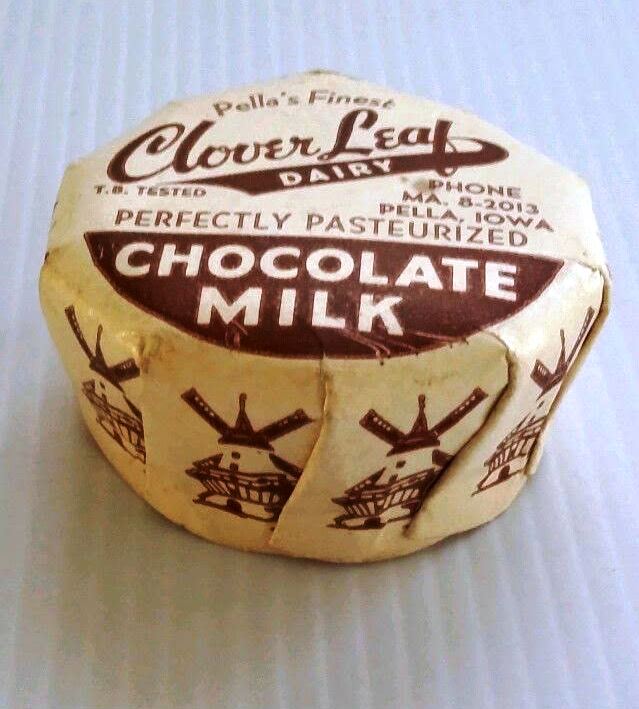
The Huyser family continued to process and sell milk at the Clover Leaf Dairy until late 1967. Bill and Stella had worked together as a team, Stella took care of the books and the bottling process along with their family. On January 4, 1967, a tragic auto accident on highway 163 left Bill a widower. Without his wife and partner he decided to sell the business to the Schwan Company.
Schwan’s food, located in Marshall Minnesota, wanted to get their products into Iowa. Schwan’s continued the process milk for around a year after they bought it.
Wayne Stienstra owns the two buildings at 312 Washington Street that were the Clover Leaf Dairy. He was honored by Historic Pella Trust in 2018 with a Historic Landmark Award for the preservation he has done on the buildings that now serve as his shop. He states that the hook for the horse harness is still up in the original location.
Support the Historic Pella Trust
